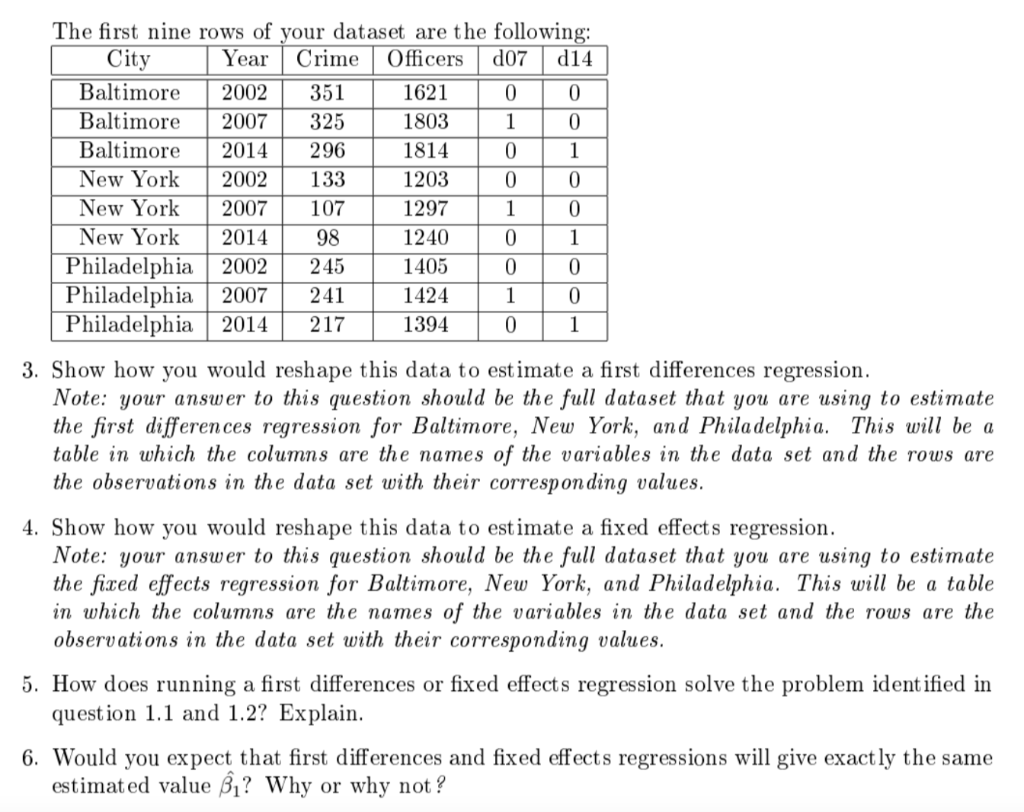

You are interested in estimating the effect of police officer presence on crime in the United States. You collect data from 46 US cities on the number of police officers and crime rates in 2002, 2007, and 2014. The dataset contains the variables: officers it= number of police officers per 100,000 residents in city i in year t crime it= number of crimes per 1,000 residents in city i in year t d07it= a dummy variable equal to 1 if the data is from 2007 and zero otherwise d14it=a dummy variable equal to 1 if the data is from 2014 and zero otherwise 1. You have in mind the following regression model: crimeit=0+0d07it+1d14it+1officerssit+ai+uit If you estimated an OLS regression model in which you regressed crime on the dummy variables and the number of officers in the city, would the estimated coefficient for 1 identify the causal effect of number of police officers on crime? Why not? The first nine rows of vour dataset are the following: 3. Show how you would reshape this data to estimate a first differences regression. Note: your answer to this question should be the full dataset that you are using to estimate the first differences regression for Baltimore, New York, and Philadelphia. This will be a table in which the columns are the names of the variables in the data set and the rows are the observations in the data set with their corresponding values. 4. Show how you would reshape this data to estimate a fixed effects regression. Note: your answer to this question should be the full dataset that you are using to estimate the fixed effects regression for Baltimore, New York, and Philadelphia. This will be a table in which the columns are the names of the variables in the data set and the rows are the observations in the data set with their corresponding values. 5. How does running a first differences or fixed effects regression solve the problem identified in question 1.1 and 1.2? Explain. 6. Would you expect that first differences and fixed effects regressions will give exactly the same estimated value 1^ ? Why or why not? You are interested in estimating the effect of police officer presence on crime in the United States. You collect data from 46 US cities on the number of police officers and crime rates in 2002, 2007, and 2014. The dataset contains the variables: officers it= number of police officers per 100,000 residents in city i in year t crime it= number of crimes per 1,000 residents in city i in year t d07it= a dummy variable equal to 1 if the data is from 2007 and zero otherwise d14it=a dummy variable equal to 1 if the data is from 2014 and zero otherwise 1. You have in mind the following regression model: crimeit=0+0d07it+1d14it+1officerssit+ai+uit If you estimated an OLS regression model in which you regressed crime on the dummy variables and the number of officers in the city, would the estimated coefficient for 1 identify the causal effect of number of police officers on crime? Why not? The first nine rows of vour dataset are the following: 3. Show how you would reshape this data to estimate a first differences regression. Note: your answer to this question should be the full dataset that you are using to estimate the first differences regression for Baltimore, New York, and Philadelphia. This will be a table in which the columns are the names of the variables in the data set and the rows are the observations in the data set with their corresponding values. 4. Show how you would reshape this data to estimate a fixed effects regression. Note: your answer to this question should be the full dataset that you are using to estimate the fixed effects regression for Baltimore, New York, and Philadelphia. This will be a table in which the columns are the names of the variables in the data set and the rows are the observations in the data set with their corresponding values. 5. How does running a first differences or fixed effects regression solve the problem identified in question 1.1 and 1.2? Explain. 6. Would you expect that first differences and fixed effects regressions will give exactly the same estimated value 1^ ? Why or why not








